by James Chester, Captain Third Artillery, U.S.A.1,2

The South-West or Gorge Front of Fort Sumter, Showing the Gate, Wharf, and Esplanade, Machicoullis Galleries on the Parapet and the Effect of the Fire from Cumming’s Point and Fort Johnson. From a Photograph
TOWARD the close of 1860, the national defenses of Charleston Harbor, consisting of Castle Pinckney, Fort Moultrie, and Fort Sumter, were garrisoned by an army of 65 men instead of the 1050 men that were required. Fort Moultrie alone, where the 65 soldiers were stationed, required 300 men for its defense, and Fort Sumter, to which they were ultimately transferred, was designed for a garrison of 650.
Fort Moultrie, at the time of which we write, was considered a rather pleasant station, Sullivan’s Island being a favorite summer resort. Many of the wealthy citizens of Charleston had their summer residences there, and indeed some of them lived there all the year round. There was a large summer hotel on the beach half-way up the island, and a horse railway connected the steamboat wharf and the hotel. The military reservation stretched across the island from the front to the back beach, like a waistbelt of moderate width, and the fort looked like a big buckle at the front end. It was a brick structure, or rather an earthen structure revetted with brick. It was bastioned on the land side, and had a scarp wall perhaps fifteen feet high; but the sand had drifted against it at some points so as almost to bury its masonry. With its full complement of men it could hardly have been held against a numerous and enterprising enemy, and with 65 men it was plainly untenable.
This garrison consisted of two skeleton companies and the regimental band of the 1st Artillery. They had occupied the fort since 1857, and were fairly well acquainted in the neighborhood. Indeed, several of the men had been enlisted at the post, and were native Carolinians. As the political pot began to boil toward the close of 1860 and secession was openly discussed, the social position of the garrison became anomalous. Army officer had always been favorites in the south; and as they were discreet and agreeable, it is not surprising, perhaps, that their society continued to be sought after, even by the most outspoken secessionists, up to the actual commencement of hostilities. But enlisted men, even in the South, were social outcasts. It was rather surprising, therefore, to find them receiving attentions from civilians. But the fact is that the soldiers of the army were never before treated with such consideration in the South as on the eve of the rebellion.3 The secessionists were determined to have the fort, and they wanted to get it without bloodshed. They had failed with the commissioned officers, and they had no better success with the soldiers: every enlisted man remained faithful to the Union.
The old commander of Fort Moultrie, Colonel John L. Gardner, was removed; the new one, Major Robert Anderson of Kentucky, arrived on November 21st. As a Southern man, he was expected to be reasonable. If he had scruples upon the question of qualified allegiance, he might surrender on demand, on purely professional grounds. No one doubted Major Anderson’s professional ability, and of course he could see the hopelessness of his situation at Moultrie. Moreover, he was a humane man, and would be unwilling to shed blood needlessly. But his actions clearly indicated that he would not surrender on demand. He continued defensive preparations with as much energy and zeal as his predecessor, and manifestly meant to fight. This was very discouraging to the preachers of bloodless secession, and when he transferred his command to Sumter their occupation was completely gone. Nothing but war would now get him out. Hence the efforts to get him ordered back again by President Buchanan—efforts which almost succeeded.
The transfer of Major Anderson’s command from Moultrie to Sumter was neatly executed early in the evening of December 26th, 1860. It was a few minutes after sunset when the troops left Moultrie; the short twilight was about over when they reached the boats; fifteen or twenty minutes more carried them to Sumter. The workmen had just settled down to an evening’s enjoyment when armed men at the door startled them. There was no parleying, no explaining; nothing but stern commands, silent astonishment, and prompt obedience. The workmen were on the wharf, outside the fort, before they were certain whether their captors were secessionists or Yankees.
Meantime the newly arrived troops were busy enough. Guards were posted, embrasures secured, and, as far as practicable, the place was put in a defensible condition against any storming-party which chagrin might drive the guard-boat people to send against it. Such an attempt was perfectly feasible. The night was very dark; the soldiers were on unknown ground and could not find their way about readily; many of the embrasures could not be closed; and there were at least a hundred willing guides and helpers already on the wharf and in a fine frame of mind for such work. But nothing was attempted, and when the soldiers felt themselves in a position to repel any attempt against them that night, two guns were fired as a signal to friends that the occupation had been successfully accomplished, and that they might proceed with their part of the programme. This was the first intimation the guard-boat people had of the transfer; and, indeed, it told them nothing, except that some soldiers must have got into Sumter. But they blew their alarm-whistle all the same, and burned blue-lights; signal-rockets were sent up from various points, and there was great excitement everywhere in the harbor until morning.
When the signal-guns were fired, the officer in charge of the two schooners which had carried provisions and ammunition to Fort Johnson (under the pretense that they were subsistence for the women and children, whom he had also carried there as a cloak) cast loose his lines and made all speed for Sumter, and the old sergeant who had been left in Moultrie for the purpose set fire to the combustibles which had been heaped around the gun-carriages, while another man spiked the guns.5 The garrison from the ramparts of its new nest grimly approved of the destruction of the old one.
At dawn of December 27th the men were up and ready for any emergency; indeed, most of them had been up all night. Captain Foster had been specially busy with his former employees. Among them he found several loyal men, and also some doubtful ones who were willing to share the fortunes of the garrison. These constituted an acceptable addition to our working strength, although those classed as doubtful would have been an element of weakness in case of a fight. However, they did much good work before hostilities began, and the worst ones were weeded out before we were close invested. Those who remained to the end were excellent men. They endured the hardships of the siege and the dangers of the bombardment without a murmur, and left Sumter with the garrison—one of them, John Swearer, severely wounded—with little besides the clothes they stood in. They were the first volunteers for the Union, but were barred from the benefits secured by legislation for the national soldiers, having never been “mustered in.”
Fort Sumter was unfinished, and the interior was filled with building materials, guns, carriages, shot, shell, derricks, timbers, blocks and tackle, and coils of rope in great confusion. Few guns were mounted, and these few were chiefly on the lowest tier. The work was intended for three tiers of guns, but the embrasures of the second tier were incomplete, and guns could be mounted on the first and third tiers only.
The complete armament of the work had not yet arrived, but there were more guns on hand than we could mount or man. The first thing to be considered was immediate defense. The possibility of a sudden dash by the enemy, under cover of darkness and guided by the discharged workmen then in Charleston, demanded instant attention. It was impossible to spread 65 men over ground intended for 650, so some of the embrasures had to be bricked up. Selecting those, therefore, essential to artillery defense, and mounting guns in them, Anderson closed the rest. This was the work of many days; but we were in no immediate danger of an artillery attack. The armament of Moultrie was destroyed; its guns were spiked, and their carriages burned; and it would take a longer time to put them in condition than it would to mount the guns of Sumter.
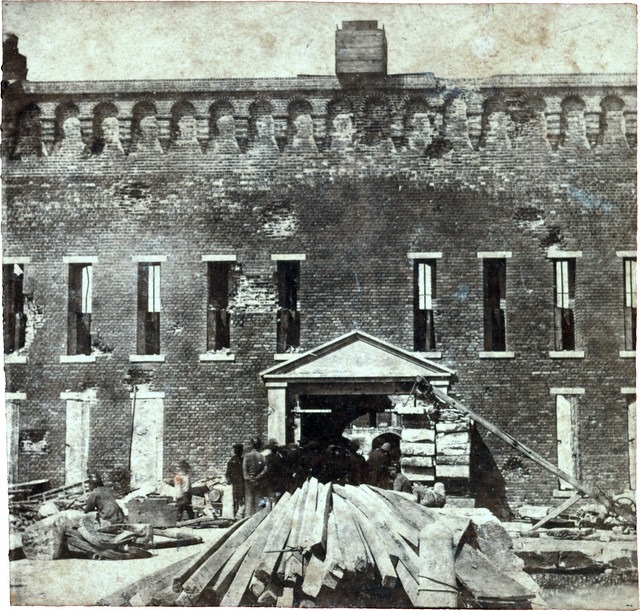
The Sally-Port of Fort Sumter.
From a Photograph Taken from the Wharf.4
On the parade were quantities of flag-stones standing on end in masses and columns everywhere. We dared not leave them where they were, even if they had not been in the way, because mortar shells bursting among them would have made the very bomb-proofs untenable. A happy idea occurred to some one in authority, and the flag-stones were arranged two tiers high in front of the casemates, and just under the arches, thus partly closing the casemates and making excellent splinter-proofs. This arrangement, no doubt, saved the garrison from many wounds similar to that inflicted on John Swearer, for it was in passing an opening unprotected by the screen that he was struck by a fragment of shell.
Moving such immense quantities of material, mounting guns, distributing shot, and bricking up embrasures kept us busy for many weeks. But order was coming out of chaos every day, and the soldiers began to feel that they were a match for their adversaries. Still, they could not shut their eyes to the fact that formidable works were growing up around them. The secessionists were busy too, and they had the advantage of unlimited labor and material. Fort Moultrie had its armament again in position, and was receiving the framework of logs which formed the foundation for its sandbag bomb-proofs. The Stevens’ Point floating battery was being made impregnable by an overcoat of railroad iron; and batteries on Morris, James, and Sullivan’s islands were approaching completion. But our preparations were more advanced than theirs; and if we had been permitted to open on them at this time, the bombardment of Sumter would have had a very different termination. But our hands were tied by policy and instructions.
The heaviest guns in Sumter were three ten-inch columbiads—considered very big guns in those days. They weighed fifteen thousand pounds each, and were intended for the gorge and salient angles of the work. We found them skidded on the parade ground. Besides these there was a large number of eight-inch columbiads—more than we could mount or man—and a full supply of 42, 32, and 24-pounders, and some eight-inch sea-coast howitzers. There was an ample supply of shot and shell, and plenty of powder in the magazines, but friction primers were not abundant and cartridge-bags were scarce. The scarcity of cartridge-bags drove us to some strange makeshifts. During the bombardment several tailors were kept busy making cartridge-bags out of soldiers’ flannel shirts, and we fired away several dozen pairs of woolen socks belonging to Major Anderson. In the matter of friction primers strict economy had to be observed, as we had no means of improvising a substitute.
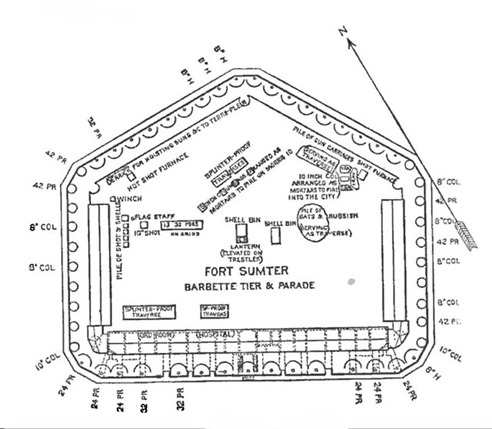
Ground-Plan of Fort Sumter
Based on an Official Drawing
Our first efforts in preparation were directed toward mounting the necessary guns on the lowest tier. These consisted of 42 and 32-pounders, and as the necessary trucks, gins, and tackle were on hand, the work went on rapidly. The men were in fine condition and as yet well fed; besides, they had the assistance of the engineer workmen, who soon because experts at this kind of work. Meantime a party of mechanics were making the main gate secure. This was situated at the middle of the gorge or base of the pentagon (the trace of the work was pentagonal), which was also the south-west side. It was closed by two heavy iron-studded gates, the outer a folding pair, and the inner arranged on pulleys, so that it could be raised or lowered at will. It was clear that the enemy, if he meant to bombard us, would erect batteries on Morris Island, and thus would be able to deliver an oblique fire on the gate sufficient to demolish it in a very few minutes. The gate once demolished, a night assault would become practicable.
To meet this possible emergency the main entrance was closed by a substantial brick wall, with a man-hole in the middle two feet wide and opposite to the man-hole in the gate. This wall was about six feet high, and to increase the security and sweep the wharf, an eight-inch sea-coast howitzer was mounted on its upper carriage without any chassis, so as to fire through the man-hole. The howitzer was kept loaded with double canister. To induce the belief that the folding gates were our sole dependence at this point, their outer surface was covered with iron.
The lower tier of guns being mounted, the more difficult operation of sending guns up to the third tier began. The terre-plein of the work was about fifty feet above parade level,—a considerable hoist,—but a pair of shears being already in position, and our tackle equal to the weight of eight-inch columbiads, the work went on amidst much good humor until all the guns of that caliber were in position.
We had now reached a problem more difficult to solve, namely, sending up our ten-inch columbiads. We were extremely desirous to have them—or at least two of them—on the upper tier. They were more powerful guns than any the enemy had at that time, and the only ones in our possession capable of smashing the iron-clad defenses which might be constructed against us. We had rumors that an iron-clad floating battery was being built in Charleston, which the enemy proposed to anchor in some convenient position so as to breach Sumter at his leisure. We had no faith in the penetrating power of the eight-inch guns, and if we wished to demolish this floating adversary, it was necessary that the ten-inch guns should be mounted. Besides, an iron-clad battery was well on the road to completion at Cumming’s Point (twelve hundred yards from the weakest side of Sumter), which, from what we could see of it, would be impervious to any less powerful gun.
There was in the fort a large coil of very heavy rope, new, and strong enough to sustain fifteen thousand pounds, but some of the doubtful workmen had cut several strands of it at various points on the outside of the coil; at least we could account in no other way for the damage. Besides, we had no blocks large enough to receive the rope even if it had been uninjured. The rope was uncoiled and examined. The portion on the inner side of the coil was found uninjured, and a few splices gave rope enough for a triple tackle sixty feet long. The improvisation of blocks of sufficient size and strength now became the sole remaining difficulty, and it was overcome in this way: the gun-carriages of those days were made of well-seasoned oak, and one of them was cut up and the material used for the construction of blocks. When the blocks were finished the iron-clad battery was shorn of half its terrors.
The tackle thus improvised was rigged on the shears, the first, gun was rolled into position for hoisting, the sling was attached, and the windlass was manned. After carefully inspecting every knot and lashing, the officer in charge gave the word, “Heave away,” and the men bent to their work steadily and earnestly, feeling, no doubt, that the battle with the iron-clad had really begun. Every eye watched the ropes as they began to take the strain, and when the gun had fairly left the skids, and there was no accident, the song which anxiety had suspended was resumed, all hands joining in the chorus, “On the plains of Mexico,” with a sonorous heartiness that might well have been heard at Fort Moultrie. The gun made the vertical passage of fifty feet successfully, and was safely landed on the terre-plein. The chassis and carriage were then sent up, transported to the proper emplacement, and put in position, and the gun was mounted.
The ten-inch columbiad threw a shot weighing one hundred and twenty-eight pounds, and it was now necessary that a supply of such shot should be raised. Of course, they could have been sent up at the derrick, but that would have been a slow process, and, moreover, it would have required the derrick and the men, when they were needed for other work. So after retreat roll-call, when the day’s work was over, the men were bantered by some designing sergeant as to their ability to carry a ten-inch shot up the stairway. Some of the soldiers, full of confidence and energy, shouldered a shot each and started. They accomplished the feat, and the less confident, unwilling to be outdone by comrades no bigger than themselves, shouldered a shot each and made the passage. In a few minutes sixty shot were deposited near the gun; and it became the custom to carry up a ten-inch shot after retreat—just for fun—as long as there were any to carry.
These trivial incidents serve to show the spirit and humor of the men better than any description. There never was a happier or more contented set of men in any garrison than the Sumter soldiers. There was no sulkiness among them, and no grumbling until they had to try their teeth on spun yarn as a substitute for tobacco. This occurred long before the ration was reduced, and it produced some of the loudest grumbling ever listened to.
The second ten-inch columbiad was less fortunate than its fellow. it reached the level of the terre-plein without accident, but almost at the first haul on the watch tackles to swing it in, it broke away and fell with a dull thud. There was no mirth in the faces of the men at the watch tackle as they looked over the edge of the parade wall to see how many of the men at the windlass were left. The gun had descended, breech first, like a bolt from a catapult, and had buried itself in the sand up to the trunnions; but beyond breaking the transoms of the derrick, no damage was done. The cause of the accident was easily discovered. The amateur block-maker, unwilling to weaken the blocks by too much trimming, had left their upper edges too sharp, and the strap of the upper block had ben cut in consequence. In four days the derrick was repaired, and the gun safely landed on the terre-plein.
The third ten-inch columbiad was not sent up. It was mounted as a mortar on the parade, for the purpose of shelling Charleston should that become advisable. A mortar platform already existed there. A ten-inch top carriage was placed on it and the gun mounted pointing toward the city.
A laughable incident occurred in connection with this gun soon after it was mounted. Some of the officers were anxious to try how it would work, and perhaps to see how true its alignment was, and to advertise to the enemy the fact that we had at least one formidable mortar in Fort Sumter. At any rate they obtained permission from Major Anderson to try the gun with a “very small charge.” So, one afternoon the gun was loaded with a blind shell, and what was considered a “very small charge” of powder. The regulation charge for the gun, as a gun, was eighteen pounds. On this occasion two pounds only were used. it was not expected that the shell would be thrown over a thousand yards, and as the bay was clear no danger was anticipated. Everything being in readiness, the gun was fired, and the eyes of the garrison followed the shell as it described its graceful curve in the direction of the city. By the time it reached the summit of its trajectory, the fact that the charge used was not a “very small” one for the gun fired as a mortar became painfully apparent to every observer, and fears were entertained by some that the shell would reach the city, or at least the shipping near the wharves. But fortunately it fell short, and did no damage beyond scaring the secessionist guard-boat then leaving the wharf for her nightly post of observation. The guard-boat put back and Sumter was visited by a flag of truce, perhaps to find out the meaning of our performance. No doubt the explanations given were satisfactory. No more experiments for range were tried with that gun, but we knew that Charleston was within range.
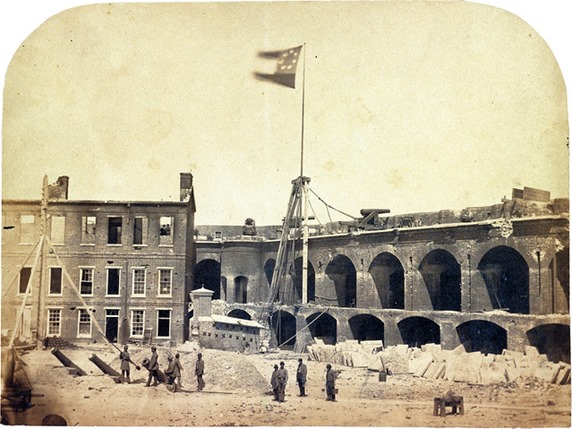
Interior of Sumter after the surrender, showing the 8-inch columbiads planted as mortars, and the confederate flag flying from the derrick by which the guns were raised to the upper tier.
Although the full armament of Sumter was not on hand, there were many more guns than places to put them. This resulted from the fact that no guns were mounted on the second tier, and because many embrasures on the first tier were bricked up. There were four unplaced eight-inch columbiads after the fort had been satisfactorily garnished with guns. But we were entirely without mortars. Perhaps this serious defect in our armament, and perhaps our success with the ten-inch gun mounted as a mortar, induced Major Anderson to mount his extra eight-inch guns in that way. Morris Island, twelve hundred yards away, was the nearest terra firma to Fort Sumter, and there the enemy would plant his most important batteries. The more searching and severe the fire that could be brought to bear upon that island, therefore, the better, so the four extra columbiads were mounted as mortars to fire in that direction. We had no carriages for the guns and no platforms. So a trench was dug in the parade at right angles to the proposed line of fire. A heavy timber was then embedded in the sand at the bottom of the trench, and another on the Morris Island side of it, in such a way that a gun resting on the one and leaning on the other would be supported at an angle of forty-five degrees. The guns were then placed in notches at equal intervals along the trench. We had no opportunity to try this novel mortar battery, but everybody was satisfied that it could have done good service.
It was expected that the walls of Fort Sumter would be able to withstand the guns which we knew the enemy possessed, but we did not anticipate importations from abroad. During the bombardment a Whitworth gun of small caliber, just received from England, was mounted in one of the Morris Island batteries, and in a few rounds demonstrated its ability to breach the work. Fortunately its supply of ammunition was limited, and the fire stopped short of an actual breach. But a few hours more of that Whitworth 12-pounder would have knocked a hole in our defenses.
A breach was not dreaded by the garrison, for, weak as it was, it could have given a good account of itself defending a breach. The greatest danger was a simultaneous attack on all sides. Sixty-four men could not be made very effective at a dozen different points. The possibility of the enemy, under cover of darkness, getting a foothold in force on the narrow bit of riprapping between tide-water and the foundation of the scarp was ever present in our minds.
The most likely place to land was the wharf, a stone structure in front of the main entrance. There an assaulting column might be formed and the main gate stormed, while the bulk of the garrison was defending the embrasures. To checkmate any such attempt, means of blowing the wharf out of existence were devised. Two five-gallon demijohns filled with powder were planted as mines, well under the wharf pavement, in such a way as to insure the total demolition of the structure by their explosion. These mines were arranged so that both should explode at the same instant. The means of firing were twofold: first, a powder-hose leading from the mines through a wooden trough buried under the pavement, and terminating in a dry well just inside the gate; second, a long lanyard connected with friction primers inserted in the corks of the powder demijohns, and extending through the trough into the well, whence it branched like a bell wire to convenient points inside the fort.
Another place offering special advantages to a storming party was the esplanade. This was a broad promenade extending the whole length of the gorge wall on the outside, and paved with immense blocks of dressed granite. As Fort Sumter was not designed to resist attack by storm, the esplanade was unswept by any fire. To remedy this defect the stone fougasse was resorted to. To the uninitiated the “fougasse” looked like a harmless pile of stones resting against the scarp wall. The only thing that would be likely to attract his attention was the bin-like inclosure of solid masonry open at the outer side, which looked like an immense dust-pan, and which he might think was a rather elaborate arrangement to hold merely a pile of stones together. There was nothing to indicate that beneath the stones, in the angle close to the scarp wall, a magazine of gunpowder lay concealed, and that behind were arrangements for firing it from the inside of the works. These harmless-looking piles of stones were mines of the deadliest kind. In addition, two eight-inch sea-coast howitzers were mounted on their upper carriages only, and placed in front of the main entrance, pointing to the right and left so as to sweep the esplanade.
The possibility of a hostile landing on the narrow strip of riprapping between the scarp wall and tide-water still remained to be provided for. Before secondary defenses were constructed, this was a continuous dead space on which a thousand men could have found a safe lodgment perfectly screened from fire and observation. The danger from such a lodgment was, that from it all our embrasures could have been assaulted at the same time. It was all-important, therefore, that the entrance by an embrasure should be made as difficult as possible. The ledge of riprapping was little more than four feet below the sills of the embrasures, and there would have been no difficulty in stepping in, if the two or three guards inside were disposed of. This fact was well known to the enemy, and we felt certain that, if he decided to attempt an assault in this way, he would consider scaling-ladders unnecessary. In order to disappoint him, therefore, we removed the riprapping in front of each embrasure to the depth of four or five feet, rolling the large stones into the water. This gave a height of eight or nine feet to the embrasure sills.
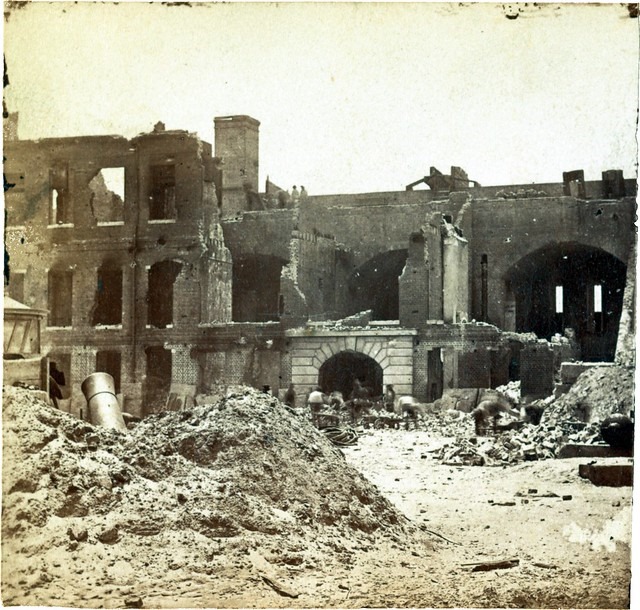
Interior of Sumter after the bombardment, showing the gate and the gorge wall; also one of the 8-inch columbiads set as mortars, bearing on Morris Island.
Machicoullis galleries were also erected on all the flanks and faces of the work. The machicoulis when completed looked like an immense dry-goods box, set upon the parapet so as to project over the wall some three or four feet. The beams upon which it rested extended inward to the terre-plein and were securely anchored down. But the dry-goods box was deceptive. Inside it was lined with heavy iron plates to make it bullet-proof. That portion of the bottom which projected beyond the wall was loop-holed for musketry, and a marksman in the machicoulis could shoot a man, however close he might be to the scarp wall. But musketry from the machicoulis could hardly be expected to beat off a determined assault upon the flanks and faces of the work. To meet this difficulty, hand-grenades were improvised. Shells of all sizes, from 12-pounders to 10-inch, were loaded, and the fuse-holes stopped with wooden plugs. The plugs were then bored through with a gimlet, and friction primers inserted. Behind the parapet at short intervals, and wherever it was thought they might be useful, numbers of these shell-grenades were stored under safe cover in readiness for any emergency. The method of throwing them was simple. Lanyards of sufficient length to reach to within about four feet of the riprapping were prepared, and fastened securely at the handle and near the piles of shell-grenades. To throw a grenade, the soldier lifted it on the parapet, hooked the lanyard into the eye of the friction primer, and threw the shell over the parapet. When the lanyard reached its length, the shell exploded. Thus a very few men would be more than a match for all that could assemble on the riprapping.
Another contrivance, the “flying fougasse,” or bursting barrel, a device of Captain Truman Seymour, consisted of an ordinary cask or barrel filled with broken stones, and having in its center a canister of powder, sufficient to burst the barrel and scatter its contents with considerable force. A fuse connected the powder in the canister with a friction primer in the bung, and the barrel was exploded by attaching a lanyard to the eye of the primer, and letting the barrel roll over the parapet, as in the case of the shell-grenade. If one experiment can justify an opinion, the flying fougasse would have been a success. When it became known in the fort that one of the barrels was about to be fired as an experiment, the novelty of the thing attracted most of the men to the place, and the little crowd attracted the attention of the enemy. No doubt glasses were focused on the party from every battery within sight. When everything was ready the barrel was allowed to roll over the parapet, and an instant afterward a terrific explosion took place. The stones were thrown in every direction, and the surface of the water was lashed into foam for a considerable distance. The effect as seen by the secessionists must have appeared greater than it did to us, although we thought it quite satisfactory. The Charleston newspapers described the effect of the “infernal machine” as simply terrific. Only three of them were constructed, yet for moral effect an empty barrel set upon the parapet would have been just as good.
In war, plan as we may, much depends upon accident, and the moral effect of very insignificant incidents is often considerable. For this reason “Wittyman’s Masterpiece” deserves to be mentioned. Wittyman was a German carpenter, not very familiar with English, and wholly ignorant of military engineering. His captain had conceived the idea that a cheval-de-frise across the riprapping at the salient angles of the fort would confine the enemy on whatever face he landed until he had been treated liberally with shell-grenades. So Wittyman was ordered to build a cheval-de-frise at the angle of the gorge nearest Morris Island. It was easy to see that Wittyman was not familiar with chevaux-de-frise, so the captain explained and roughly illustrated the construction. At last Wittyman seemed to grasp the idea and went to work upon it forthwith. Perhaps the work was not examined during construction, nor seen by any one but Wittyman until it was placed. But from that day forward it was the fountain of amusement for the men. No matter how sick or sad a man might be, let him look at the masterpiece and his ailments were forgotten. Not a steamer passed,—and they were passing almost every hour,—but every glass on board was leveled at the masterpiece. But it baffled every one of them. Not one could guess what it was, or what it was intended to be; and after the bombardment was over we learned, quite accidentally, that it had been set down by the enemy as a means of exploding the mines.
Any description of the siege of Sumter would be incomplete without some sort of reference to the Star of the West fiasco. At reveille on the 9th of January, it became generally known among the men that a large steamer flying the United States flag was off the bar, seemingly at anchor. There had been some talk among the men, based upon rumors from Charleston, that the garrison would either be withdrawn from the harbor or returned to Fort Moultrie; and there were some who believed the rumors. These believers were now confident that withdrawal had been determined on, and that the steamer off the bar was the transport come to take them away. There was no denying that appearances favored the theory, yet there was no enthusiasm. The men were beginning to feel that they were a match for their adversaries, and they were loath to leave without proving it. And, indeed, at that time Sumter was master of the situation. Moultrie had very few guns mounted,—only one, according to report,—and that fact ought to have been known to the people on the Star of the West. It was known officially in Washington that fourteen days previously Major Anderson had spiked the guns and burned the carriages at Moultrie, and gun-carriages cannot be replaced in two weeks when they have to be fabricated. Hence Moultrie could not have been formidable, and as soon as it should have passed the battery on Morris Island, it would have been comparatively safe.
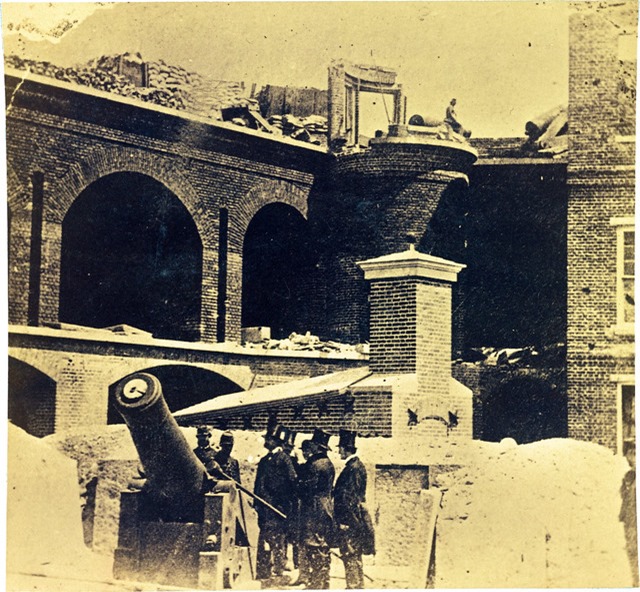
Interior of Fort Sumter—the 10-inch columbiad bearing on Charleston.
When the Star of the West was seen standing in, the novelty of a steamer carrying the national flag had more attractions for the men than the breakfast table. They soon made her out to be a merchant steamer, as the walking-beam, plainly visible as she rounded into the channel, was unknown on a man-of-war. She had taken the Morris Island channel, and was approaching at a fair rate of speed. Perhaps every man in Sumter was on the ramparts, but there was no excitement. But when the blue puff of smoke from a hidden battery on Morris Island advertised the fact that she was being fired on, there was great scurrying and scampering among the men. The long roll was beaten, and the batteries were manned almost before the guns of the hidden battery had fired their second shot. As she approached, a single gun at Fort Moultrie opened at extreme long range, its shot falling over half a mile short. There seemed to be much perplexity among our officers, and Major Anderson had a conference with some of them in a room used as a laundry which opened on the terre-plein of the sea-flank. The conference was an impromptu one, as Captain Doubleday and Lieutenant Davis were not of it. But Captain Foster was there, and by his actions demonstrated his disappointment at the result. He left the laundry, bounding up the two or three steps that led to the terre-plein, smashing his hat, and muttering something about the flag, of which the words “trample on it” reached the ears of the men of at the guns, and let them know that there was to be no fighting, on their part at least. Meantime the steamer had worn ship, and was standing out again, receiving the fire of the hidden battery in passing. This is about all the men saw or knew about the strange vessel at the time, although she came near enough for them to look down upon her decks and see that there were no troops visible on her.6
With the exception of the mounting of the guns, the preparations described were chiefly intended to ward off assault. The actions of the enemy now indicated that he proposed to bombard the work at an early day. If we would meet Moultrie, and the numerous batteries which were being constructed against us, on anything like even terms, we must be prepared to shoot accurately.
Few artillerymen, without actual experience, have any idea of the difficulty of aiming a gun during a bombardment. They may be able to hit a target in ordinary practice with absolute certainty, and yet be unable to deliver a single satisfactory shot in a bombardment. The error from smoke is difficult to deal with, because it is a variable, depending upon the density of the smoke clouds which envelop your own and your adversary’s batteries. (Within the writer’s experience, a thin veil of fog protected a mass of army wagons—900, it was said—from the fire of some 8 or 10 guns, during a whole forenoon, although the guns were within easy range, and the wagons could be distinctly seen. Refraction saved them, every shot going over.) The danger and its consequent excitement are also disturbing elements, especially where delicate instruments have to be used. It is easier to lead a forlorn hope than to set a vernier under a heavy artillery fire. Fortunately, we had officers of experience in Sumter, and fortunately, too, we had very few instruments; one gunner’s level and two old quadrants being the extent of the outfit, with perhaps some breech-sights and tangent-scales. The paucity of aiming-instruments, and perhaps the experience of some of the officers, led to the devising of instruments and methods which neither smoke nor excitement could disturb; and as some of them, in a much more perfect form, have since been adopted, the rude originals may as well be described here. Aiming cannon consists of two distinct operations: namely, alignment and elevation. In the former, according to instructions and practice, the gunner depends upon his eye and the cannon-sights. But for night firing or when the enemy is enveloped in smoke,—as he is sure to be in any artillery duel,—the eye cannot be depended on. Visual aiming in a bombardment is a delusion and a snare. To overcome this difficulty, on clear days, when all the conditions were favorable to accuracy, and we could work at our leisure, every gun in the armament was carefully aimed at all the prominent objects within its field of fire, and its position marked on the traverse circle, the index being a pointer securely fastened to the traverse fork. After this had been done, alignment became as easy as setting a watch, and could be done by night or day, by the least intelligent soldier in the garrison.
The elevation was more difficult to deal with. The ordinary method by the use of a breech-sight could not be depended on, even if there had been a sufficient supply of such instruments, because darkness or smoke would render it inapplicable or inaccurate; and the two quadrants in the outfit could not be distributed all over the fort.
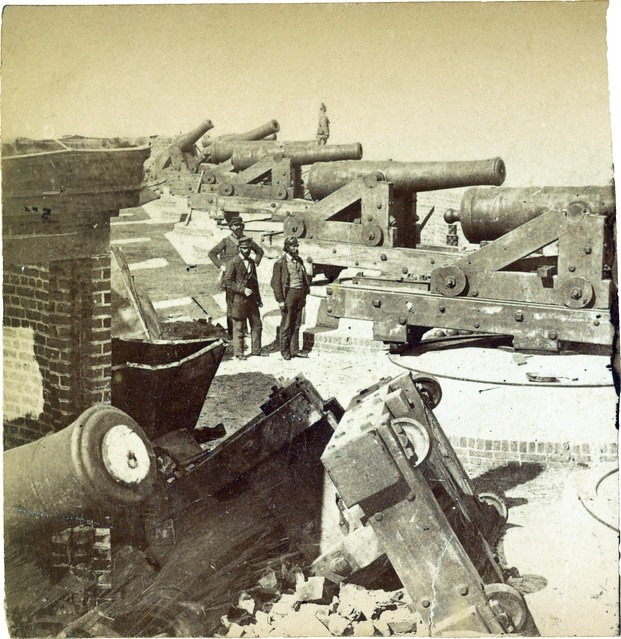
Effect of the bombardment on the barbette guns of the sea front of Sumter.
Before the correct elevation to carry a shot to a given object can be determined, it is necessary to know the exact distance of the object. This was obtained from the coast-survey chart of the harbor. The necessary elevation was then calculated, or taken from the tables, and the gun elevated accordingly by means of the quadrant. The question then became, How can the gunner bring the gun to this elevation in the heat of action, and without the use of a quadrant? There was an abundance of brass rods, perhaps a quarter-inch in diameter, in the fort. Pieces of such rods, eighteen inches long, were prepared by shaping one end to fit into a socket on the cheek of the carriage, and the other into a chisel edge. They were called by the men pointing rods. A vertical line was then drawn on the right breech of the gun, and painted white. The non-commissioned officer who attended to this preparation, having carefully elevated the gun with the quadrant for a particular object, set the pointing rod in the socket, and brought its chisel end down on the vertical line. The point thus cut was marked and the initials of the object to be struck with that elevation written opposite. These arrangements, which originated with Captain Doubleday, were of great value during the bombardment.
The preparation of Sumter for defense afforded a fine field for ingenuity, because nothing connected with its equipment was complete. As another illustration of this ingenuity, the following is in point. It might become desirable to continue a bombardment into the night, and the casemates, owing to the partial closing up of the arches with flagstones, were as dark as dungeons, even on very clear nights. Lights of some kind were absolutely necessary, but there were no candles and no lamps. There was a light-house on the fort, however, and the light-keeper had several barrels of oil on hand. Small tubes of tin, to receive wicks, were made, and fitted into disks of cork sufficiently large to float them on the surface of the oil. Coffee-cups were then filled with oil and the floats laid on the surface.
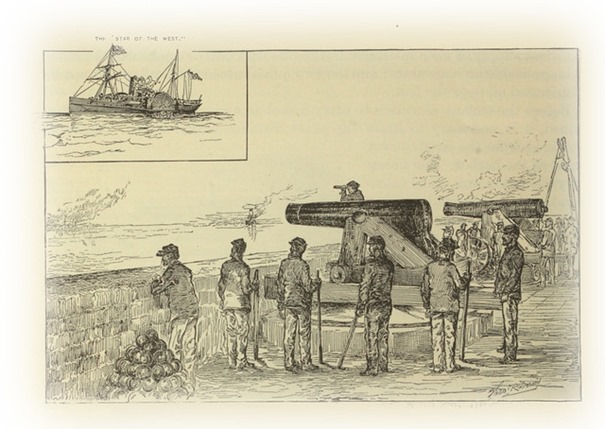
The Sumter garrison watching the firing on the “Star of the West.”
Fort Moultrie is shown on the left, and the smoke of the Morris Island battery on the extreme right.
Among the many incidents of the siege may be mentioned the mishap of an ice-laden Yankee schooner that strayed within range of the secession batteries; the accidental solid shot fired at Fort Sumter by an impatient secessionist in the Cumming’s Point battery, and the daring generosity of McInerny, warm-hearted and loyal Irishman, who did not “cross the broad Atlantic to become the citizen of only one Shtate,” and who cheerfully risked his life and ruined his Sunday shirt by tearing a white flag from it, that he might be able to deliver in person his donation of tobacco to the besieged soldiers. There is one other incident which should find a place in these reminiscences.
Major Anderson was fully impressed with the solemn responsibilities which rested upon him when he transferred his command to Sumter. When he reached Sumter there were no halliards to the flag-staff, and as there was more pressing work on hand for several days, some time elapsed before it became possible to display the national flag. At length, however, halliards were rigged, and everything was ready for the flag. The usual method of proceeding in such a case would have been to order the sergeant of the guard to send up the flag, but it was otherwise arranged on this occasion. A dress-parade was ordered, and the little garrison formed around the flag-staff, the officers in the center. Presently Major Anderson, with Chaplain Harris of Fort Moultrie, who perhaps had been summoned for the purpose, approached the flag-staff, and the command was brought to “Attention.” The flag, already bent to the halliards, was held by one officer, and another held the hoisting end of the halliards. The chaplain then, in a few words, invited those present to join with him in prayer, and Major Anderson, receiving the halliards from the officer who till that time had held them, knelt beside the chaplain, most of the officers and some of the men in the ranks following his example. Prayers being ended, all rose, and the flag of Fort Sumter was raised by Major Anderson, and the halliards secured. He then turned toward the officers and directed that the companies be dismissed. If any of those who doubted the loyalty to the Union of Major Anderson could have had but one glimpse of that impressive scene, they would have doubted no longer.
The weary waiting for war or deliverance which filled up the few weeks that intervened between the preparations and the actual bombardment developed no discontent among the men, although food and fuel were getting scarce. The latter was replenished from time to time by tearing down sheds and temporary workshops, but the former was a constantly diminishing quantity, and the men could count on their fingers the number of days between them and starvation. It was a favorite belief among the secessionists that the pinchings of hunger would arouse a spirit of mutiny among the soldiers, and compel Major Anderson to propose terms of evacuation. But no such spirit manifested itself. On the contrary, the men exhibited a devotion to their Government and the officers appointed over them which surprised their enemies, but attracted little attention from their friends.7
The opening of the bombardment was a somewhat dramatic event. A relieving fleet was approaching, all unknown to the Sumter garrison, and General Beauregard, perhaps with the hope of tying Major Anderson’s hands in the expected fight with that fleet, had opened negotiations with him on the 11th of April looking toward evacuation of the fort. But Major Anderson declined to evacuate his post till compelled by hunger. The last ounce of breadstuffs had been consumed, and matters were manifestly approaching a crisis. It was evident from the activity of the enemy that something important was in the wind. That night we retired as usual. Toward half-past three on the morning of the 12th we were startled by a gun fired in the immediate vicinity of the fort, and many rose to see what was the matter. It was soon learned that a steamer from the enemy desired to communicate with Major Anderson, and a small boat under a flag of truce was received and delivered the message. Although no formal announcement of the fact was made, it became generally known among the men that in one hour General Beauregard would open his batteries on Sumter.
The men waited about for some time in expectation of orders, but received none, except an informal order to go to bed, and the information that reveille would be sounded at the usual hour. This was daylight, fully two hours off, so some of the men did retire. The majority perhaps remained up, anxious to see the opening, for which purpose they had all gone on the ramparts. Except that the flag was hoisted, and a glimmer of light was visible at the guard-house, the fort looked so dark and silent as to seem deserted. The morning was dark and raw. Some of the watchers surmised that Beauregard was “bluffing,” and that there would be no bombardment. But promptly at 4:30 A. M. a flash as of distant lightning in the direction of Mount Pleasant, followed by the dull roar of a mortar, told us that the bombardment had begun. The eyes of the watchers easily detected and followed the burning fuse which marked the course of the shell as it mounted among the stars, and then descended with ever-increasing velocity, until it landed inside the fort and burst. It was a capital shot. Then the batteries opened on all sides, and shot and shell went screaming over Sumter as if an army of devils were swooping around it. As a rule the guns were aimed too high, but all the mortar practice was good. In a few minutes the novelty disappeared in a realizing sense of danger, and the watchers retired to the bomb-proofs, where they discussed probabilities until reveille.
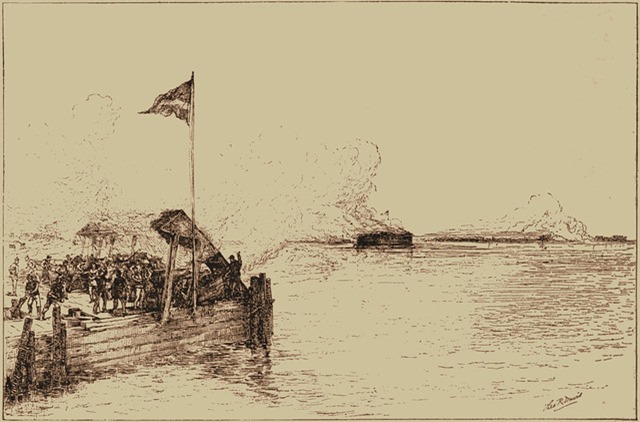
Confederate Floating Battery in Action at the West End of Sullivan’s Island
Habits of discipline are strong among old soldiers. If it had not been for orders to the contrary, the men would have formed for roll-call on the open parade, as it was their custom to do, although mortar-shells were bursting there at the lively rate of about one a minute. But they were formed under the bomb-proofs, and the roll was called as if nothing unusual was going on. They were then directed to get breakfast, and be ready to fall in when “assembly” was beaten. The breakfast part of the order was considered a grim joke, as the fare was reduced to the solitary item of fat pork, very rusty indeed. But most of the men worried down a little of it, and were “ready” when the drum called them to their work.
By this time it was daylight, and the effects of the bombardment became visible. No serious damage was being done to the fort. The enemy had concentrated their fire on the barbette batteries, but, like most inexperienced gunners, they were firing too high. After daylight their shooting improved, until at 7:30 A. M., when “assembly” was beaten in Sumter, it had become fairly good. At “assembly” the men were again paraded, and the orders of the day announced. The garrison was divided into two reliefs, and the tour of duty at the guns was to be four hours. Captain Doubleday being the senior captain, his battery took the first tour.
There were three points to be fired upon,—the Morris Island batteries, the James Island batteries, and the Sullivan’s Island batteries. With these last was included the famous iron-clad floating battery, which had taken up a position off the western end of Sullivan’s Island to command the left flank of Sumter. Captain Doubleday divided his men into three parties: the first, under his own immediate command, was marched to the casemate guns bearing on Morris Island; the second, under Lieutenant Jefferson C. Davis, manned the casemate guns bearing on the James Island batteries; and the third—without a commissioned officer until Dr. Crawford joined it—was marched by a sergeant8, 9 to the guns bearing on Sullivan’s Island. The guns in the lower tier, which were the only ones used during the bombardment,—except surreptitiously without orders,—were 32 and 42-pounders, and some curiosity was felt as to the effect of such shot on the iron-clad battery. The gunners made excellent practice, but the shot were seen to bounce off its sides like pease. After battering it for about an hour and a half, no visible effect had been produced, although it had perceptibly slackened its fire, perhaps to save ammunition. But it was evident that throwing 32-pounder shot at it, at a mile range, was a waste of iron, and the attention of the gunners was transferred to Fort Moultrie.
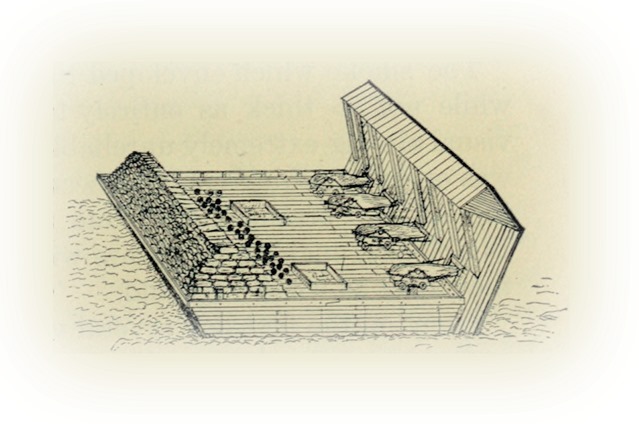
The iron-clad floating battery,
from a plan by Colonel Joseph A. Yates10
mpg Moultrie was, perhaps, a less satisfactory target than the iron-clad. It was literally buried under sand-bags, the very throats of the embrasures being closed with cotton-bales. The use of cotton-bales was very effective as against shot, but would have been less so against shell. The fact that the embrasures were thus closed was not known in Sumter till after the bombardment. It explained what was otherwise inexplicable. Shot would be seen to strike an embrasure, and the gunner would feel that he had settled one gun for certain, but even while he was receiving the congratulations of his comrades the supposed disabled gun would reply. That the cotton-bales could not be seen from Sumter is not surprising. The sand-bag casemates which covered the guns were at least eighteen feet thick, and the cotton-bale shutter was no doubt arranged to slide up and down like a portcullis inside the pile of sand-bags. The gunners of Sumter, not knowing of the existence of these shutters, directed their shot either on the embrasures for the purpose of disabling the enemy’s guns, or so as to graze the sand-bag parapet for the purpose of reaching the interior of the work. The practice was very good, but the effect, for reasons already stated, was inconsiderable.
At the end of the first four hours, Doubleday’s men were relieved from the guns and had an opportunity to look about them. Not a man was visible near any of the batteries, but a large party, apparently of non-combatants, had collected on the beach of Sullivan’s Island, well out of the line of fire, to witness the duel between Sumter and Moultrie. Doubleday’s men were not in the best of temper. They were irritated at the thought that they had been unable to inflict any serious damage on their adversary, and although they had suffered no damage in return they were dissatisfied. The crowd of unsympathetic spectators was more than they could bear, and two veteran sergeants determined to stir them up a little. For this purpose they directed two 42-pounders on the crowd, and, when no officer was near, fired. The first shot struck about fifty yards short, and, bounding over the heads of the astonished spectators, went crashing through the Moultrie House. The second followed an almost identical course, doing no damage except to the Moultrie House, and the spectators scampered off in a rather undignified manner. The Moultrie House was flying a yellow flag at the time, and the Charleston newspapers discoursed upon the barbarity of firing upon a hospital flag, forgetting, perhaps, that we also had a hospital in Sumter, which they treated to red-hot shot during the bombardment. Of course, none of the officers of Sumter knew anything about the two 42-pounder shot.
The smoke which enveloped the Confederate batteries during the first day, while not so thick as entirely to obscure them, was sufficiently so to make visual aiming extremely unreliable; and during the second day, when Sumter was on fire, nothing could be seen beyond the muzzles of our own guns. But the aiming arrangements, due to the foresight and ingenuity of Captain Doubleday, enabled us to fire with as much accuracy when we could not see the object as when we could.
Early on the first day several vessels of the fleet were observed off the bar, and orders were given to dip the flag to them. This was done, and the salute was returned, but while our flag was being hoisted after the third dip, a shell burst near the flag-staff and cut the halliards. This accident put the flag beyond our control. It ran down until the kinky halliards jammed in the pulley at the mast-head, and the flag remained at about half-staff. This has been interpreted as a signal of distress, but it was only an accident. There was no special distress in Sumter, and no signal to that effect was intended.
Major Anderson had given orders that only the casemate batteries should be manned. While this was undoubtedly prompted by a desire to save his men, it operated also, in some degree, to save the Confederates. Our most powerful batteries and all our shell guns were on the barbette tier, and, being forbidden their use, we were compelled to oppose a destructive shell fire with solid shot alone. This, especially as we had no mortars, was a great disadvantage.
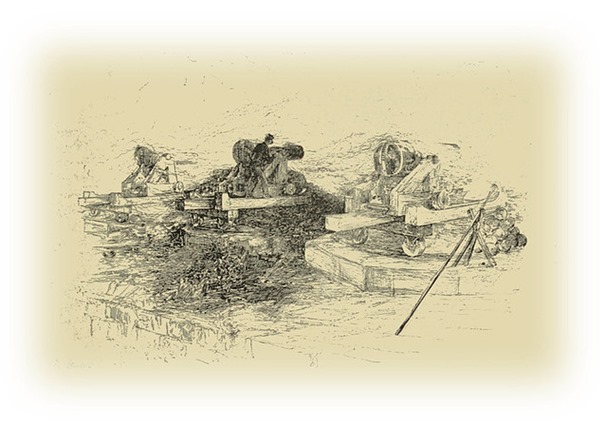
Sergeant John Carmody firing the barbette guns
Had we been permitted to use our shell guns we could have set fire to the barracks and quarters in Moultrie; for, as it was, we wrecked them badly with solid shot, although we could not see them. Then the cotton-bale shutters would have been destroyed, and we could have made it much livelier generally for our adversaries. This was so apparent to the men, that one of them—a man named Carmody—stole up on the ramparts and deliberately fired every barbette gun in position on the Moultrie side of the work. The guns were already loaded and roughly aimed, and Carmody simply discharged them in succession; hence, the effect was less than it would have been if the aim had been carefully rectified. But Carmody’s effort aroused the enemy to a sense of his danger. He supposed, no doubt, that Major Anderson had determined to open his barbette batteries, so he directed every gun to bear on the barbette tier of Fort Sumter, and probably believed that the vigor of his fire induced Major Anderson to change his mind. But the contest was merely Carmody against the Confederate States; and Carmody had to back down, not because he was beaten, but because he was unable, single-handed, to reload his guns.
Another amusing incident in this line occurred on the Morris Island side of the fort. There, in the gorge angle, a ten-inch columbiad was mounted, en barbette, and as the 42-pounders of the casemate battery were making no impression on the Cumming’s Point iron battery, the two veteran sergeants who had surreptitiously fired upon the spectators, as already related, determined to try a shot at the iron battery from the big gun. As this was a direct violation of orders, caution was necessary. Making sure that the major was out of the way, and that no officers were near, the two sergeants stole upstairs to the ten-inch gun. It was loaded and aimed already, they very well knew, so all they would have to do was to fire it. This was the work of a few seconds only. The gun was fired, and those in the secret down below watched the flight of the shot in great expectations of decided results. Unfortunately the shot missed; not a bad shot—almost grazing the crest of the battery—but a miss. A little less elevation, a very little, and the battery would have been smashed: so thought the sergeants, for they had great faith in the power of their gun; and they determined to try a second shot. The gun was reloaded, a feat of some difficulty for two men, but to run it “in battery” was beyond their powers. It required the united efforts of six men to throw the carriage “in gear,” and the two sergeants could not budge it. Things were getting desperate around them. The secessionists had noticed the first shot, and had now turned every gun that would bear on that ten-inch gun. They were just getting the range, and it was beginning to the uncomfortable for the sergeants, who in a fit of desperation determined to fire the gun “as she was.” The elevating screw was given half a turn less elevation, and the primer was inserted in the vent. Then one of the sergeants ran down the spiral stairs to see if the coast were clear, leaving his comrade in a very uncomfortable position at the end of the lanyard, and lying flat on the floor. It was getting hotter up there every second, and a perfect hurricane of shot was sweeping over the prostrate soldier. Human nature could stand it no longer. The lanyard was pulled and the gun was fired. The other sergeant was hastening up the stairway, and had almost reached the top, when he met the gun coming down, or at least trying to. Having been fired “from battery,” it had recoiled over the counter-hurters, and, turning a back somersault, had landed across the head of the stairway. Realizing in a moment what had happened, and what would be to pay if they were found out, the second sergeant crept to the head of the stairway and called his comrade, who, scared almost to death,—not at the danger he was in, but at the accident,—was still hugging the floor with the lanyard in his hand. Both got safely down, swearing eternal secrecy to each other; and it is doubtful if Major Anderson ever knew how that ten-inch gun came to be dismounted. It is proper to add that the shot was a capital one, striking just under the middle embrasure of the iron battery and half covering it with sand. If it had been a trifle higher it would have entered the embrasure.
The first night of the bombardment was one of great anxiety. The fleet might send reënforcements; the enemy might attempt an assault. Both would come in boats; both would answer in English. It would be horrible to fire upon friends; it would be fatal not to fire upon enemies. The night was dark and chilly. Shells were dropping into the fort at regular intervals, and the men were tired, hungry, and out of temper. Any party that approached that night would have been rated as enemies upon general principles. Fortunately nobody appeared; reveille sounded, and the men oiled their appetites with the fat pork at the usual hour by way of breakfast.
The second day’s bombardment began at the same hour as did the first; that is, on the Sumter side. The enemy’s mortars had kept up a very slow fire all night, which gradually warmed up after daylight as their batteries seemed to awaken, until its vigor was about equal to their fire of the day before. The fleet was still off the bar—perhaps waiting to see the end. Fire broke out once or twice in the officers’ quarters, and was extinguished. It broke out again in several places at once, and we realized the truth and let the quarters burn. They were firing red-hot shot. This was about 9 o’clock. As soon as Sumter was noticed to be on fire the secessionists increased the fire of their batteries to a maximum. In the perfect storm of shot and shell that beat upon us from all sides, the flag-staff was shot down, but the old flag was rescued and nailed to a new staff. This, with much difficulty, was carried to the ramparts and lashed to some chassis piled up there for a traverse.
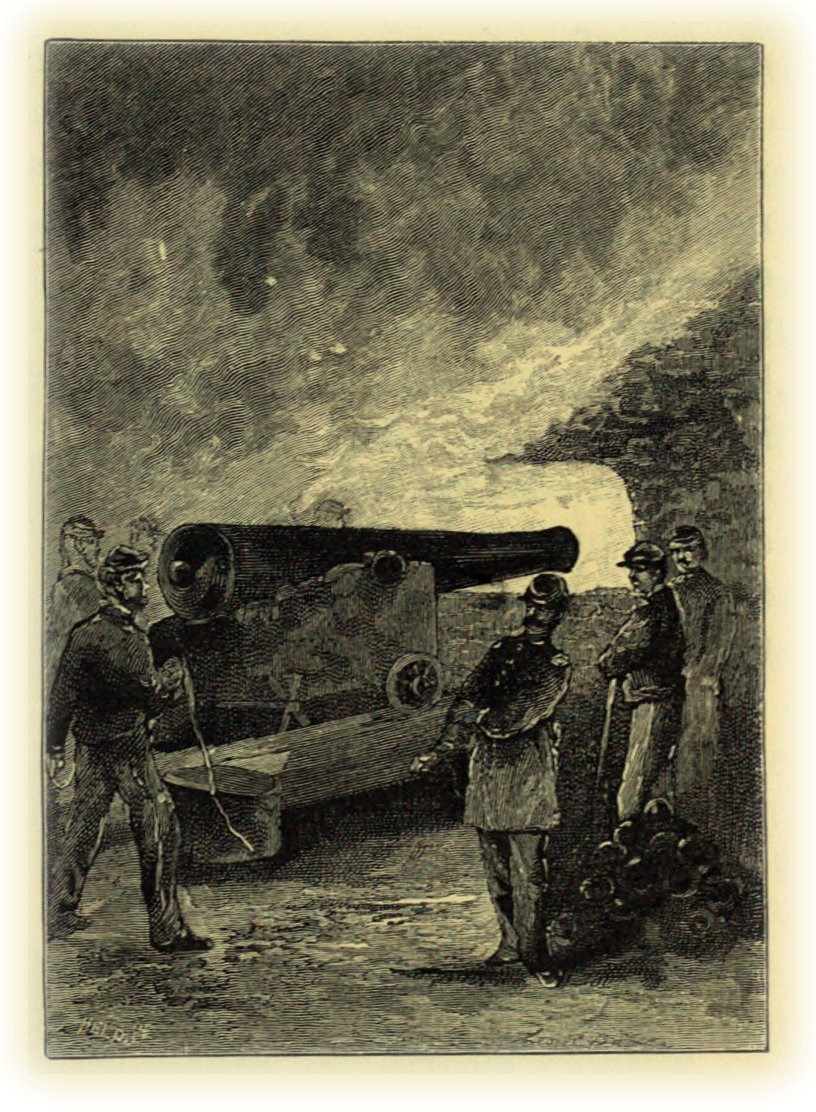
A casemate gun during the conflagration
We were not sorry to see the quarters burn. They were a nuisance. Built for fire-proof buildings, they were not fire-proof. Neither would they burn up in a cheerful way. The principal cistern were large iron tanks immediately under the roof. These had been riddled, and the quarters below had been deluged with water. Everything was wet and burned badly, yielding an amount of pungent piney smoke which almost suffocated the garrison.
The scene inside the fort as the fire gained headway and threatened the magazine was an exciting one. It had already reached some of our stores of loaded shells and shell-grenades. These must be saved at all hazard. Soldiers brought their blankets and covered the precious projectiles, and thus the most of them were saved. But the magazine itself was in danger. Already it was full of smoke, and the flames were rapidly closing in upon it. It was evident that it must be closed, and it would be many hours before it could be opened again. During these hours the fire must be maintained with such powder as we could secure outside the magazine. A number of barrels were rolled out for this purpose, and the magazine door—already almost too hot to handle—was closed.
It was the intention to store the powder taken from the magazine in several safe corners, covering it with damp soldiers’ blankets. But safe corners were hard to find, and most of the blankets were already in use covering loaded shells. The fire was raging more fiercely than ever, and safety demanded that the uncovered powder be thrown overboard. This was instantly done, and if the tide had been high we should have been well rid of it. But the tide was low, and the pile of powder-barrels rested on the riprapping in front of the embrasure. This was observed by the enemy, and some shell guns were turned upon the pile, producing an explosion which blew the gun at that embrasure clear out of battery, but did no further damage.
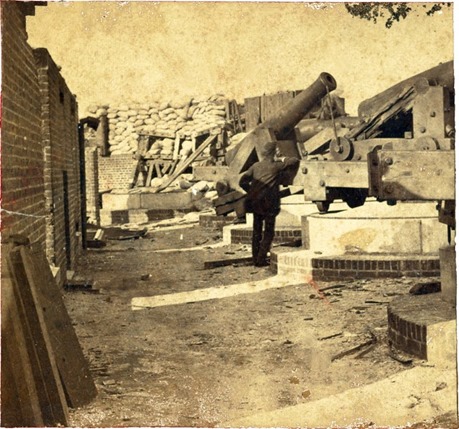
Barbette guns—Effect of the raking fire from Fort Moultrie
The fire had now enveloped the magazine, and the danger of an explosion was imminent. Powder had been carried out all the previous day, and it was more than likely that enough had sifted through the cartridge-bags to carry the fire into the powder-chamber. Major Anderson, his head erect as if on parade, called the men around him; directed that a shot be fired every five minutes; and mentioned that there was some danger of the magazine exploding. Some of the men, as soon as they learned what the real danger was, rushed to the door of the magazine and hurriedly dug a trench in front of it, which they kept filled with water until the danger was considered over.
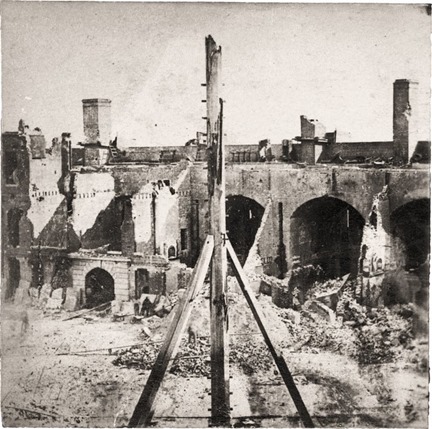
Ruins of the casemates near the sally-port, and of the flag-staff.
It was during this excitement that ex-Senator Wigfall of Texas visited the fort. It came the turn of one of the guns on the left face of the work to fire,—we were now firing once in five minutes,—and as the cannoneer approached for the purpose of loading, he discovered a man looking in at the embrasure. The man must have raised himself to the level of the embrasure by grasping the sill with his hands. A short but lively altercation ensued between the man and the cannoneer, the man pleading to be taken in lest he should be killed with his own shot and shell. He was hauled in, Thompson, the cannoneer, first receiving his sword, to the point of which a white handkerchief was attached, not by way of surrender, but for convenience. Once inside, the bearer asked to see Major Anderson. The major was soon on the spot and opened the conversation by asking, “To what am I indebted for this visit?” The visitor replied, “I am Colonel Wigfall, of General Beauregard’s staff. For God’s sake, Major, let this thing stop. There has been enough bloodshed already.” To which the major replied, “There has been none on my side, and besides, your batteries are still firing on me.” At which Wigfall exclaimed, “I’ll soon stop that,” and turning to Thompson, who still held the sword under his arm, he said, pointing to the handkerchief, “Wave that out there.” Thompson then handed the sword to Wigfall, saying, in substance, “Wave it yourself.” Wigfall received back his sword and took a few steps toward the embrasure, when the major called him back, saying, “If you desire that to be seen you had better send it to the parapet.” There was a good deal more said on the subject of the white flag both by Wigfall and the major which the writer cannot recall, but the end of it all was that a white flag was ordered to be displayed from the parapet at the request of Colonel Wigfall, and pending negotiations with him, which was instantly done, a hospital sheet being used for the purpose. Then the firing gradually ceased, and the major and his officers and Colonel Wigfall retired into the hospital bomb-proof, the only habitable room left. This was about 3 o’clock in the afternoon.
Wigfall’s conference was not of long duration. He left the fort in the small boat which brought him from Morris Island, and which was manned by negroes. Shortly after his departure another small boat from Sullivan’s Island, containing officers in full uniform (Wigfall wore citizen’s dress with the sword), approached the fort. The officers in this boat were very much astonished and annoyed at being warned off by the sentinel, and compelled to show a white flag before they were permitted to approach. They were received by the officers of the day, who apologized for not meeting them afloat, saying that all our boats had been destroyed by shot or burned up. They were indignant at their reception, and demanded to know whether or not the fort had surrendered. What was said in reply was not distinctly heard by the writer, but it was believed to be a negative. The officer then asked what the white flag meant, and Wigfall’s name was mentioned in reply. About this time Major Anderson made his appearance, and the visitors, still talking in an indignant tone, addressed themselves to him. What was said seemed to be a repetition of what had just been said to the officer of the day. The major’s replies were inaudible where the writer of this stood, except when he raised his hand in a sweeping sort of gesture in the direction of Fort Moultrie, and said, “Very well, gentlemen, you can return to your batteries.” They did not return, however, immediately, but were conducted into the hospital where Wigfall had been, and remained there some time. When they left we learned that there would be no more firing until General Beauregard had time to hear from his Government at Montgomery.
About 7 o’clock in the evening another white flag brought the announcement that the terms agreed upon between General Beauregard and Major Anderson had been confirmed, and that we would leave Fort Sumter the following day; which we did, after saluting our our flag with fifty guns.
- Chester, James. “Inside Sumter in ’61.” Essay in Battles and Leaders of the Civil War, edited by Clarence Clough Buel and Robert Underwood Johnson, Vol. 1. New York, NY: The Century Co., 1887.
- Chester, James. “The First Scenes of the Civil War.” The United Service. A Monthly Review of Military and Naval Affairs. Vol.10, no. 6, June 1884.
- An amusing incident which illustrates this occurred during the election excitement in November, 1860. Elections in South Carolina were always peculiar. It could hardly be said that there were two parties, but there generally were two candidates for every office in the State. In such cases the candidates would each give a barbecue or feast of some kind to the voters, at which stump speeches were delivered in a somewhat florid style. The whole body of voters attended both entertainments, and it is to be feared decided rather upon the merits of the feast than the fitness of the candidate. At one of these entertainments on Sullivan’s Island, the regimental band attended,—hired as an attraction,—and such soldiers as were on pass gathered around the outskirts of the crowd which surrounded the open-air supper table. The supper was over, and the speaking had begun. Everything eatable had been devoured except a remnant of ham which rested on a platter in front of the chairman—who perhaps was also the candidate—at one end of the long table. The chairman was speaking, and the audience was enthusiastic. A storm of applause had just broken out at something the speaker had said, when a soldier, who had had his eyes on the fragment of ham for some time, deliberately mounted the table at the lower end, and carefully picking his steps among the dishes, walked to the chairman’s end, picked up the coveted fragment, and started on the return trip. The audacity of the man stunned the audience for a moment, but indignation soon got the better of astonishment, and the soldier was in some danger of rough treatment. But the chairman had his revolver out in a second, and holding it aloft proclaimed: “I’ll shoot the first man who interferes with that soldier.” And the soldier carried off the fragment. Of course he was drunk; but he could not have done the same thing without a drubbing in 1859. This anecdote—and others might be related—indicates the policy and perhaps the expectations of the secessionists in connection with the soldiers of Fort Moultrie.—J. C.
- Abner Doubleday tells a different story of the burning of the gun-carriages and spiking the guns.
- The original images in the 1887 Battles and Leaders of the Civil War were block prints from engravings. As much as possible, images in this Chronicles of the American Civil War page are from online copies of the photos that were the sources used for the engravings. The remaining images are from the best that could be found of the many versions of the book freely available online.
- The troops on the Star of the West consisted of 200 men, under Lieut. Charles R. Woods.—Editors (Johnson/Buel)
- So faithful and true have the soldiers of the army always been that even very striking exhibitions of these qualities are not considered worthy of notice. There were military posts in 1861 which were abandoned by all the commissioned officers, at which not one of the enlisted men proved untrue. The loyalty of the latter has never been properly appreciated.—J. C.
- The non-commissioned officers in Fort Sumter were Ordnance-Sergeant James Kearney, U. S. A., Quartermaster-Sergeant William H. Hammer, 1st U. S. Artillery; Regimental Band, 1st Artillery: Sergeant James E. Galway, Corporal Andrew Smith; Company E, 1st Artillery: First Sergeant Eugene Scheibner, Sergeants Thomas Kirnan, William A. Harn, and James Chester, Corporals Owen M’Guire, Francis J. Oakes, Charles Bringhurst, and Henry Ellerbrook; Company H, 1st Artillery: First Sergeant John Renehan, Sergeants James M’Mahon, John Carmody, and John Otto, Corporal Christopher Costolan.—Editors (Johnson/Buel)
- In his The First Scenes of the Civil War, the Captain Chester identifies the seargent commanding the 3rd artillery party as himself. “The third party was marched by myself to the guns bearing on Fort Moultrie, the Sullivan’s Island batteries, and the ironclad floating battery, which was moored close to the Sullivan’s Island shore. Very soon after fire was opened, the post surgeon, who for some time had been doing line duty, joined the third party, and was the only commissioned officer with it throughout the bombardment.”
- Colonel Joseph A. Yates, who was a lieutenant in the attack on Fort Sumter, says in a letter accompanying the plan of the next page: “I send a rough sketch of the floating battery which I commanded; it is rough, but from my recollection it is very like her. The battery was substantially built, flat, heavily timbered on her shield, with railroad iron laid on it—two courses of rails turned inward and outward, so as to form a pretty smooth surface. The bags of sand represented on the deck were to counterweigh the guns, which were 32 and 42-pounders. She was struck many times, several shot going entirely through the shield.”